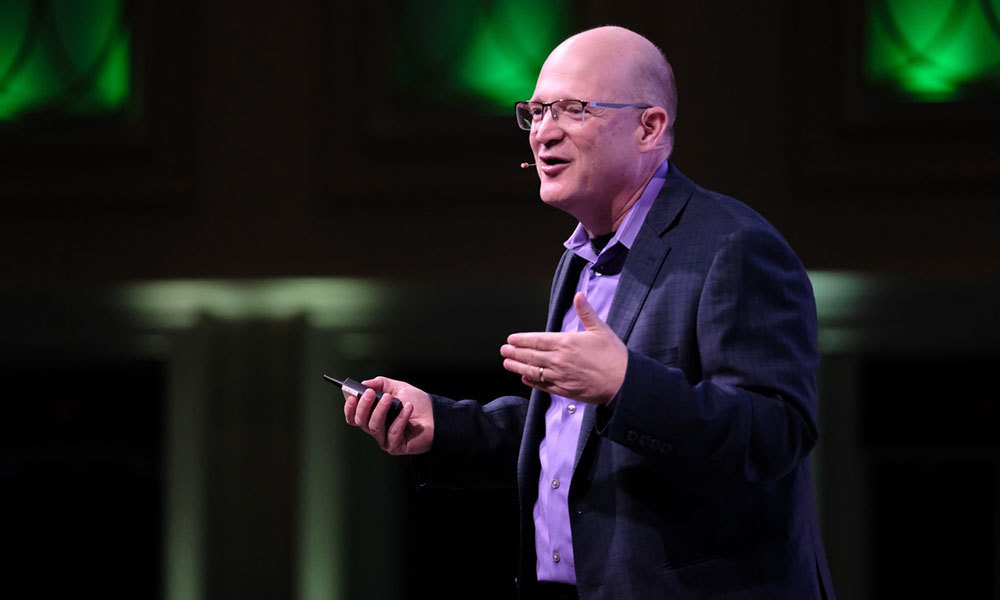
Lessons in Experience Design From XDP
It was all about shifting mindsets at ASAE's Xperience Design Project Thursday, where meeting planners, marketers, learning professionals, and industry partners spent the day considering how thinking like a designer can transform their events.
What’s your favorite escape? If you’re an aficionado of spinning classes, you’ll probably understand Lisa Kay Solomon’s choice: SoulCycle.
The spinning-turned-dance-party workouts at SoulCycle “allow me to escape my daily routine and be part of a fully immersive experience that captures my heart, my body, and my head. That’s what a great experience does,” said Solomon, chair of transformational practices at Singularity University, opening ASAE’s Xperience Design Project event in National Harbor, Maryland, Thursday morning.
Her message to her audience of hundreds of association professionals who came to reimagine their organizations’ events: “Escapes can be designed—in fact many escapes are, and you don’t even realize it. We are here to help you believe that you are capable of designing experiences that create value beyond what you thought was imaginable.”
Doing that requires a different way of thinking about association events, breaking out of the traditional conference formula and embracing experimentation and a designer’s mindset, said Solomon, who served as the day’s host. That theme carried across three content “zones” focused on marketing, learning, and operations, which attendees rotated through as the day progressed.
Designers think about more than logistics, they think about tapping emotions, Solomon said.
“You should start by finding out what makes for a great day, what brings [attendees] joy, what allows them to be successful,” she said. “Notice, this is not ‘Do you like my product?’ This is about them. This is about understanding how you create value for them from their standpoint. That is empathy and deep customer understanding.”
Don Neal, founder and CEO of 360 Live Media, leading the Marketing Zone, picked up that thread: “One of the things that clears the fog away is having an objective view of the audience,” he said, urging participants to develop detailed profiles of their attendees for more effective marketing. “The person who knows the most about the customer or the membership is the smartest person in the room.”
Marketing sets the stage for the experience, Neal said, and that work should start early if it’s to be effective. Early messaging can take the form of a “pre-suasion campaign” that builds awareness, context, and interest in a meeting—but, notably, doesn’t attempt to drive registration. “You don’t need to be selling in every communication,” he said.
Meanwhile, in the Operations Zone, David Peckinpaugh, president of Maritz Global Events, likewise encouraged participants to get an early start on involving industry partners in designing the event experience. While the traditional conference model generates a “vendorama” where suppliers work independently to deliver a slice of the event, organizations today need to embrace a partnership mindset with their vendor team.
“Involving [partners] in the design of the event from day one can transform the event. It is a true accelerator,” boosting the attendee experience and driving better business results for the organization, he said.
And once the event is underway, learning experiences are magnified if education incorporates elements of game design, said Learning Zone leader Karl Kapp, director of the Institute for Interactive Technologies. “So often, our learning design is too much about content and not enough about action. Game design is all about action. Give learners something to do.” Examples include actual games, problem solving, and role playing, he said.
In whatever form, the learning experience should present a challenge. “Often we hit our learners over the head with everything we think they should know, and we don’t let them struggle for anything,” Kapp said. “Think about the time that you’ve learned the most. It probably comes from a time of struggle.”
Ultimately, design “is about sweating the small stuff,” Solomon said.
“It’s about doubling down on every single detail. You need to know what’s happening at every step: What happens when you reach out to your members with that first email? What happens when they try to register? What happens when they find their seats?” she said. “It’s the attention to detail that defines the experience.”
Karl Kapp, director of the Institute for Interactive Technologies. (Chris Williams/Zoeica Images)






Comments